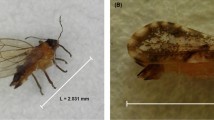Abstract
Cryptolæmus montrouzieri Mulsant (Coccinellidæ, Coleoptera), which was imported in 1892 by Albert Koebele1 into California from Australia to attack the citrus mealybugs, is a well-known predator on different mealybugs and is second in importance only to Rodolia cardinalis Mulsant. A considerable literature has accumulated on its importation into and colonization later in various countries such as France, Italy, Egypt, Philippines, Hawaii, etc., for dealing with various mealybug pests, particularly Pseudococcus spp. attacking different plants.
This is a preview of subscription content, access via your institution
Access options
Subscribe to this journal
Receive 51 print issues and online access
$199.00 per year
only $3.90 per issue
Buy this article
- Purchase on Springer Link
- Instant access to full article PDF
Prices may be subject to local taxes which are calculated during checkout
Similar content being viewed by others
References
Essig, E. O., “Insects of Western North America”, 415 (Macmillan Co., New York, 1926).
Williams, Francis X., “Handbook of Insects and other Invertebrates of Hawaiian Sugarcane Fields”, 185 (Hawaiian Sugar Planters Association, Honolulu, Hawaii, 1931).
Author information
Authors and Affiliations
Rights and permissions
About this article
Cite this article
PUTTARUDRIAH, M., CHANNABASAVANNA, G. & KRISHNA MURTI, B. Discovery of Cryptolæmus montrouzieri Mulsant (Coccinellidæ, Coleoptera, Insecta) in Bangalore, South India. Nature 169, 377–378 (1952). https://doi.org/10.1038/169377a0
Issue Date:
DOI: https://doi.org/10.1038/169377a0
Comments
By submitting a comment you agree to abide by our Terms and Community Guidelines. If you find something abusive or that does not comply with our terms or guidelines please flag it as inappropriate.



